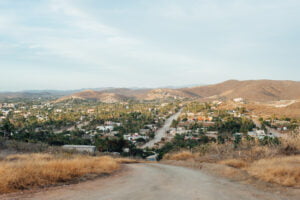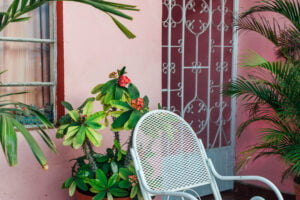There are a lot of unmarked roads in Mexico’s Baja California Sur. You see them from the smooth highway that connects the sleepy town of Todos Santos to the glossy resorts of Los Cabos an hour south, their dusty trails carving mysterious paths through fields dotted with tall saguaro cacti. They look a little intimidating, but as one local told me during a recent visit, “when you see a dirt road in Baja, you should take it. There’s always something interesting at the other end.”
There are a lot of unmarked roads in Mexico’s Baja California Sur. You see them from the smooth highway that connects the sleepy town of Todos Santos to the glossy resorts of Los Cabos an hour south, their dusty trails carving mysterious paths through fields dotted with tall saguaro cacti. They look a little intimidating, but as one local told me during a recent visit, “when you see a dirt road in Baja, you should take it. There’s always something interesting at the other end.”
And, as the saying goes, fortune favors the bold—and those who’ve rented a car with four-wheel drive. For the slow exploration of these roads yields a trove of discoveries: An oasis where the mouth of an underground spring feeds a grove of palm trees with fronds as green as a desert mirage. Or, a secluded beach where cerulean waves crash between a craggy, mermaid cove.
This wild sense of possibility has drawn a small stream of travelers to Todos Santos for decades. Some come to surf the nearby breaks, widely regarded as among the country’s best. Others, to wander the cobblestone streets lined with tiny artisan shops and refurbished haciendas in the old part of town. Still others come to while away the hours at the iconic Hotel California’s long wooden bar, which, contrary to local lore, is not the same lovely place named in the Eagles song. The area is so enchanting that in 2006, the Mexican government designated Todos Santos a Pueblo Mágico—one of just 100 or so small towns honored for its natural beauty, cultural riches, or historical relevance.
Now, a whole new set of travelers is setting their sights on another treasure at the end of a dirt road: the just-opened Hotel San Cristóbal.
The hotel, located on a previously undeveloped fishing beach called Punta Lobos about 15 minutes south of town, is the first international project from famed Texas hotelier Liz Lambert. Her Bunkhouse Group is known for its highly photogenic boutique properties in Austin and Marfa—hotels that helped put those places on the map for a certain style-conscious, nomadic set. And, now, just one month after opening its doors, the Hotel San Cristóbal is topping that same set of travelers’ must-visit lists—and generating a healthy amount of buzz elsewhere, too. Last year, the New York Times named Todos Santos one of its top 50 travel destinations thanks, in part, to the impending opening of the hotel, and more recently the retailer Madewell launched a partnership with the property. On the weekend I visited, all 32 rooms were fully booked with blissed-out couples in their 20s and 30s wearing colorful serape kimonos and sipping mezcal margaritas by the long, turquoise-tiled pool.
If all this sounds too cool, don’t worry—it totally is. The San Cristóbal—with its swirly tiled floors, brightly woven blankets, terra-cotta-potted cacti, and bubble gum–pink pool floats—is an Instagrammer’s nirvana, an aesthete’s wet dream. And that is precisely part of what makes it so fun. It is clear that every single element of the hotel has been painstakingly executed for maximum sensory enjoyment, and there’s a specifically modern delight that comes from noticing all the small details that make up the sum: The candlesticks in the library with their artfully dripped wax, the three large fireplaces tucked into different nooks, the curtains in the guest rooms with their pretty bamboo pulls, and the woodsy smoke of copal incense that trails you wherever you go. Even the setting of the sun—which is marked each evening with the ringing of a giant gong—feels perfectly orchestrated; it dips below the horizon in exact alignment with the pool, allowing for unobstructed views of the glowing Pacific from wherever you choose to lounge.
Of course, the addition of this type of gleaming tourist draw in an underdeveloped slice of paradise doesn’t come without its share of controversy. The Hotel San Cristóbal is tied to Tres Santos, a large development company that angered residents when it announced ambitious plans to build up to 4,500 residences in a town with a population that currently hovers around just 7,000. Tres Santos was accused of bogarting the small town’s water supply and displacing the local fishermen, who had been using the beach at Punta Lobos for generations. And more generally, many residents see this all as a sign of the impending destruction of their once relatively undiscovered desert utopia. “We don’t want this to be the next Cabo, or even the next Tulum,” is the oft-repeated refrain.
But others—residents who live in the area all year and whose livelihoods depend on tourism—see the arrival of Tres Santos and San Cristóbal less negatively. “Todos Santos has so much to offer—beaches, farming, culture—that development is going to happen here anyway. It is just a matter of time,” one local surf instructor explained. “Most of the people who are angry about it are the ones who come for the winter and leave as soon as the slow season starts. If they were here the whole time and had to make a living, they might feel differently.”
And, anyway, the San Cristóbal is a far cry from the massive, all-inclusives that dominate many of the country’s better-known resort towns. As with Lambert’s other properties, a sense of community permeates the property; the staff is made up almost entirely of locals who are quick to point out the region’s many treasures and the activities on offer to guests include several volunteer opportunities, like shepherding baby sea turtles back to the sea or fostering a local pup or helping out on one of the region’s farms. The hotel’s restaurant is helmed by Mexican chef Edgar Palau, who—in addition to his focus on local ingredients—makes a point of inviting guests to accompany him to select the day’s fresh catch from the fishermen who share the beach with the hotel.
Here, a look at some of the area’s other highlights should you decide to go.
What to Do:
Surfing has a long history in Baja culture, and Playa Cerritos, located about 20 minutes south of town, is no doubt the most popular beach for newbies and experts alike; it’s relatively easy to get to (down another dirt road) and offers both a gentle beach break and a more adventurous rocky point break. Boards, wetsuits, and lessons are available from Mario Surf School, which is located in a tent on the north end of the beach near the Hacienda.
For those who prefer to dry land adventures, the surrounding Sierra de la Laguna mountain range is ideal for hiking and mountain biking. One popular hike is to the top of Punta Lobos, which affords breathtaking views of an abandoned fishing port where a sea lion colony has made its home.
Where to Eat:
For some of the best Baja-style fish tacos—battered, deep-fried white fish heaped with mango salsa and crisp cabbage—visit La Copa Cocina, the intimate restaurant on the shaded terrace behind The Todos Santos Inn. Cafe Santa Fe, which offers upscale Italian, is widely regarded as the town’s best restaurant and is a good option when you’re craving a break from ceviche and moles. Outside of town, take advantage of the area’s stellar agriculture by dining on wood-fired pizza and super fresh salads at Hierbabuena, a sweet alfresco restaurant located within an organic farm. Nearby, Baja Beans is a must for coffee and baked goods; on the weekends during high season it is also the sight of a bustling farmers’ market and excellent people watching.
Where to Stay:
If you prefer to stay in town, there are plenty of lovely alternatives to the beachside San Cristóbal. One favorite is La Bohemia, a collection of six whitewashed adobe rooms tucked into an oasis of palm trees and cacti just a few blocks from the historic town center. Owned by a pair of Cali transplants who decided to put down roots in Baja after taking a road trip to the area several years ago, the sweet hotelito incorporates many traditional elements in its design: Otomi embroidered headboards, hand-painted Talavera tiles, and hand-woven textiles. Up the street at Hotel Casa Tota the aesthetic is more minimalist, though no less comfortable. Housed in a historic brick building that was once a general store, the hotel’s 15 pared down rooms face a welcoming central courtyard with a deep blue pool. The views of the surrounding palm-studded hills and quiet streets from the rooftop make you feel as if you’re looking down on a vintage postcard of L.A.
But perhaps the most romantic place to stay in town is Todos Santos Inn, set in a former hacienda that was built by a sugar baron in the 1800s. With its faded murals, arched walkways, and antique furniture, it looks straight out of another era.




